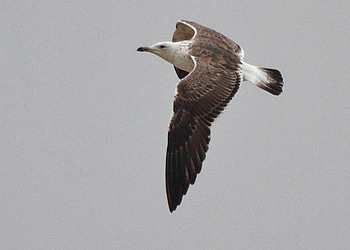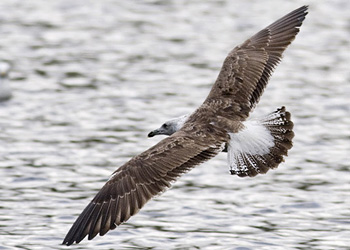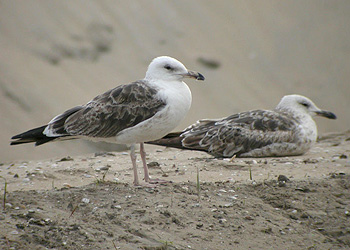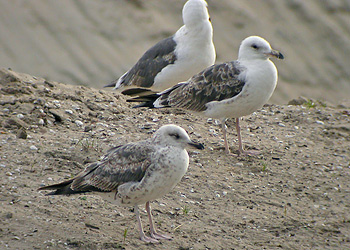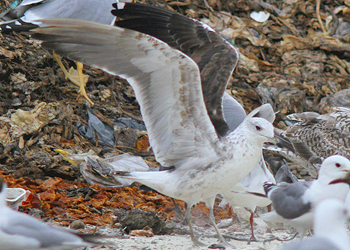 nominate Lesser Black-backed Gull (L. f. fuscus)
nominate Lesser Black-backed Gull (L. f. fuscus)
(last update:
Amir Ben Dov (Israel)
Hannu Koskinen (Finland)
Mars Muusse (the Netherlands)
fuscus 1cy July
fuscus 1cy Aug
fuscus 1cy Sept
fuscus 1cy Oct
fuscus 1cy Nov
fuscus 1cy Dec
fuscus 2cy Jan
fuscus 2cy Feb
fuscus 2cy March
fuscus 2cy April
fuscus 2cy May
fuscus 2cy June
fuscus 2cy July
fuscus 2cy Aug
fuscus 2cy Sept
fuscus 2cy Oct
fuscus 2cy Nov
fuscus 2cy Dec
fuscus 3cy Jan
fuscus 3cy Feb
fuscus 3cy March
fuscus 3cy April
fuscus 3cy May
fuscus 3cy June
fuscus 3cy July
fuscus 3cy August
fuscus 3cy Sept
fuscus 3cy October
fuscus 3cy Nov
fuscus 3cy Dec
fuscus 4cy Jan
fuscus 4cy Feb
fuscus 4cy March
fuscus 4cy April
fuscus 4cy May
fuscus 4cy June
fuscus 4cy July
fuscus 4cy Aug
fuscus 4cy Sept
fuscus 4cy Oct
fuscus 4cy Nov
fuscus 4cy Dec
fuscus ad Jan
fuscus ad Feb
fuscus ad March
fuscus ad April
fuscus ad May
fuscus ad June
fuscus ad July
fuscus ad Aug
fuscus unringed Aug
fuscus ad Sept
fuscus ad Oct
fuscus ad Nov
fuscus ad Dec
Field identification criteria for second calendar-year Baltic Gull
Ruud Altenburg, Ies Meulmeester, Mars Muusse, Theo Muusse & Pim Wolf
- GULL RESEARCH ORGANISATION -
IN: Dutch Birding 33: 304-311, 2011
Subspecific identification of Lesser Black-backed Gulls Larus fuscus took flight in the late 1990s, when Jonsson (1998) and Rauste (1999) published their landmark papers on the identification of Baltic Gull L f fuscus (and Heuglin's Gull L heuglini). Jonsson (1998) classified nominate fuscus into three identifiable age classes: 1 second calendar-year birds in spring; 2 third calendar-year birds in spring; and 3 adults in autumn. Armed with Jonsson's (1998) well-defined identification criteria, many of which centred around moult, birders in western Europe set out to find vagrant nominate fuscus. Their subsequent field observations, however, indicated that the variation in the western taxa L f graellsii and, particularly, L f intermedius had been rather underestimated by Jonsson (1998) and Rauste (1999). Consequently, identification appeared to be far less straightforward than previously assumed. This applied in particular to third calendar-year birds and adults (cf Gibbins 2004, Muusse et al 2005, Winters 2006).
Winters (2006) reviewed Jonsson's (1998) original identifiable age groups based on data collected primarily in the Netherlands. He defined three 'identifiable types' of nominate fuscus which, in short, comprised:
1 second calendar-year birds in spring/summer showing at least eight new primaries and preferably a plumage typical of nominate fuscus;
2 second calendar-year birds in autumn showing three generations of primaries; and
3 third calendar-year birds in spring showing two generations of primaries, with the outer ones still fresh and P10 showing a small mirror.
His paper did not deal with adults but Gibbins (2004) had already addressed the identification problems for this age group.
Given the uncertainties about fail-safe identification criteria for nominate fuscus, rarities committees such as the Dutch rarities committee (CDNA) decided to only accept (colour-)ringed birds of known age and provenance. The CDNA, however, acknowledged that this practice might be too restrictive, and also that published literature might allow for a broader range of acceptable 'types'. For that reason, the CDNA asked us to review existing literature and to match these data with our own field experience in order to investigate whether any age/plumage 'types' can be identifiable with enough certainty as to allow acceptance by the CDNA. The current paper summarises the results of this investigation.
Material and methods
As part of ongoing research stimulated by the Gull Research Organisation (www.gull-research.org), we collected data on ringed second calendar-year western birds (n=146) from the period mid-March to late June (see below), comprising graellsii (including so-called 'Dutch intergrades'; n=86) from Belgium, Britain, France, Germany and the Netherlands, as well as intermedius (n=60) from Denmark, Norway and Sweden. Between mid-March and late June, the extent of the post-juvenile moult of tail-feathers, secondaries and primaries in virtually all second calendar-year Lesser Black-backed Gulls can still be reliably assessed; later in the season, this assessment is progressively obscured by advancing complete moult. The moult stage of birds observed by the authors was scored in the field, while the remainder were scored from photographs. Tail-feathers were considered only if the entire tail could be scored, and secondaries if all feathers in at least one wing were visible. Only the outer five primaries were scored, as these are visible at rest and therefore could be scored in all birds.
Compared with previous studies, our study comprised a larger database of individuals of known age and provenance (based on ringing details), leading to more robust conclusions about the prospect of safely identifying birds in certain age or plumage classes.
Second calendar-year birds
In this paper, we concentrate on second calendar-year nominate fuscus because our studies indicate that this age-class is the most safely identifiable, based on moult and plumage characters. We present a set of criteria that, in our opinion,
enables safe identification of well-observed and well-documented individuals that meet the proposed criteria. Our criteria will enable observers in the field to make certain identifications and
national or regional rarities committees to consider reports of unringed nominate fuscus.
Moult and ageing
Graellsii/intermedius
The variation in moult timing in second calendar-year birds mirrors that of third calendar-year birds (as described in Muusse et al 2005). On average, post-juvenile moult in intermedius is more extensive than in graellsii. Replacement of tail-feathers during the first winter is rather uncommon in graellsii (five out of 27 birds (19%), all from the Netherlands) but regular in intermedius (10 out of 17 (59%), from Denmark and Norway). None of the 18 graellsii that could be scored for replaced flight-feathers showed second generation secondaries, versus three out of 14 (21%) intermedius. The most advanced individual, from southern Norway, had replaced all tail-feathers and half of its secondaries. None of the 86 graellsii or 60 intermedius had replaced any of the outer five primaries; moreover, none of the 17 graellsii and 14 intermedius for which the entire wing could be scored showed arrested moult in the inner primaries.
Given the extensive variation in Lesser Black-backed Gull, our sample of ringed birds is unlikely to tell the complete story. Indeed, from June onwards, it is not uncommon to observe second calendar-year (graellsii/)intermedius-type birds that have replaced all secondaries. In rare cases, such western-type birds even have renewed a few inner primaries (Winters 2006; pers obs). Although plumage-wise these birds resemble intermedius, some may actually represent fuscus (cf Altenburg et al 2007).
Olsen & Larsson (2004) quote Peter Adriaens, stating that 'very few [second calendar-year] intermedius/graellsii [are as] similarly advanced [as nominate fuscus]'. PA (pers comm) has since commented that 'similarly advanced' was an expression too vague and ambiguous, and mainly referred to moult of the wing-coverts, tail-feathers and secondaries'. He confirmed 'not yet having seen a colour-ringed, second calendar-year graellsii/intermedius that had replaced primaries in winter'.
Graellsii/intermedius commence the first complete moult in the spring of their second calendar-year. By July-August, their plumage will either show obvious moult gaps or look very fresh. In many birds, the worn juvenile outer primaries are still present; in others the wing looks atypically short because the outer primaries are missing or growing. Second calendar-year graellsii/intermedius do not acquire a full set of second generation primaries before the end of September (pers obs), when they finish their complete moult.
Nominate fuscus
For nominate fuscus, a complete moult in the first winter is the norm, with two-thirds of the birds returning to Finland having replaced all flight-feathers (Rauste 1999, Koskinen & Rauste 2006). The majority of the second calendar-year nominate fuscus in western Europe are observed in May-June, when they are relatively easily detected by their advanced plumage, including glossy black second generation primaries with rounded tips (plate 385 and 387). Moult in summer is restricted in those second calendar-year fuscus that have completely renewed their plumage on the wintering grounds (Rauste 1999, Koskinen & Rauste 2006). During their stay in Europe, their appearance hardly changes. In July-August, some of the advanced birds start replacing second generation inner primaries to third generation feathers (see Koskinen & Rauste 2006), whereas in others moult is limited to just some wing-coverts. This contrasts strongly with second calendar-year graellsii/intermedius which undergo a complete moult in summer. When the quality of the plumage, particularly the primaries, can be properly assessed, 'spring' second calendar-year fuscus therefore can be identified into August (plate 386).
Some advanced second calendar-year nominate fuscus are very difficult to age. In addition to having a plumage with a high proportion of near-black, adult-like feathers, these birds may already show a yellow bill (sometimes also with a hint of a red gonys spot), a red orbital ring and pale yellow legs; these features make them strongly resemble third calendar-year birds (plate 388). However, the flight-feathers should provide a strong clue to their real age: second generation inner primaries are all-black or have a narrow white tip (<10 mm), whereas third generation ones are more adult-like and have a (much) broader tip (>10 mm).
In spring, advanced second calendar-year nominate fuscus can be misidentified as third calendar-year intermedius, as both show second generation flight-feathers. The best character to separate dark-mantled third calendar-year intermedius from advanced second calendar-year nominate fuscus is the state of wear in the flight-feathers. In second calendar-year nominate fuscus, the central and outer primaries have been replaced in late winter, so these feathers normally look fresh in spring. In third calendar-year intermedius, these feathers have been replaced several months earlier, so they are more worn. Third calendar-year intermedius often moult tail-feathers to third generation feathers in the winter quarters (Muusse et al 2005) and return to Europe with a checkered tail-bar or all-white tail-feathers, whereas second calendar-year nominate fuscus should show a distinct tail-bar, often white tipped. An example of an incorrectly aged bird is plate 206 in Winters (2006), showing a second calendar-year nominate fuscus wrongly identified as a third calendar-year graellsii/intermedius.
Second calendar-year nominate fuscus typically show upperparts consisting of a mix of plain dark brown and blackish-grey feathers (plate 385-388). The adult-like feathers in some individuals are slightly paler grey, possibly reflecting the considerable variation in mantle colour in adults (Barth 1966, Jonsson 1998). Occasionally, birds are observed with eight or more second generation primaries but with a plumage strongly differing from the norm. A strongly marked ('barred') plumage (plate 389) is common in graellsii/intermedius but unusual in fuscus. Although data on the phenotype of intergrades is lacking, such 'barred' individuals could potentially represent intergrades between intermedius and fuscus from mixed Norwegian colonies. Individuals with unusually pale grey plumage (plate 390), on the other hand, are potential Heuglin's Gull candidates. In his description of 'identifiable types' of second calendar-year fuscus, Winters (2006) argued that a typical plumage pattern was 'preferable'. In our view, a plumage typical for second calendar-year fuscus is essential for positive identification. Individuals with a plumage obviously deviating from the norm should not be considered.
Any second calendar-year Lesser Black-backed Gull showing three generations of primaries in autumn has replaced less than 10 primaries on the wintering grounds and then suspended its moult. After migrating north, rather than continuing with the next remaining juvenile primary, they recommence with P1 and replace a number of second generation inner primaries during the summer months (plate 391). We concur with Winters (2006) that such a scenario is extremely unlikely to occur in the western taxa and should be considered exclusive for nominate fuscus.
Criteria for identifiable second calendar-year
nominate fuscus
Second calendar-year nominate fuscus is variable. Some individuals do not replace any primaries on the wintering grounds and such birds are regularly inseparable from graellsii/intermedius (cf, eg, Altenburg et al 2006). The majority, however, show a full set of second generation primaries in spring, a feature that has never been recorded in ringed (and hence proven) second calendar-year graellsii/intermedius. On the basis of our sample of western-type birds and published data on nominate fuscus (Koskinen & Rauste 2006), we argue that any second calendar-year Lesser Black-backed Gull, in the period April-June, showing the following set of characters can safely be classified as nominate fuscus:
1 all rectrices, secondaries and at least eight primaries are second generation feathers; the primaries and tail should be checked for very advanced individuals that can be mistaken for third calendar-year birds;
2 the upperparts are plain dark brown, mixed with dark grey to blackish-grey adult-like feathers. In some birds, the dark brown scapulars may have acquired paler fringes due to wear, while in others a faint pattern on the (greater) coverts may be visible. Birds that show scapulars and/or wing-coverts with obvious markings (cf plate 389) or unusually pale grey adult-type feathers (cf plate 390), however, should not be considered. Note that blackish-grey scapulars and plain upperwing-coverts alone are supportive characters only and not exclusive for nominate fuscus, because a combination of both is sometimes found in intermedius (cf, eg, plate 226 in Altenburg et al 2006).
As the appearance of advanced second calendar-year fuscus does not change dramatically during summer, basically the same criteria apply to birds in July-August. During this period, identifiable second calendar-year fuscus should show a full set of slightly to moderately worn second generation primaries, or they should already be replacing the inner primaries to third generation feathers. Second calendar-year fuscus that returned to Europe with one or two juvenile outer primaries may be replacing these feathers in summer and could potentially be confused with the most advanced intermedius. Therefore, in July-August, only birds that have returned with a full set of second generation primaries should be considered. In autumn, second calendar-year birds showing three generations of primaries can also be accepted as fuscus. The detection of such a moult pattern requires very close attention and detailed photographs.
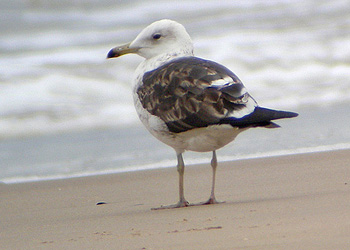 |
 |
| 388 Presumed Baltic Gull Larus fuscus fuscus, second calendar-year, Heemskerk, Noord-Holland, Netherlands, 13 June 2010 (Ruud G M Altenburg). Very advanced individual that could easily be taken for third calendar-year. Careful assessment of plumage is required to determine age in birds like this. Note that, on current criteria, this bird cannot be accepted by the Dutch rarities committee (CDNA) and is therefore referred to as presumed. | |
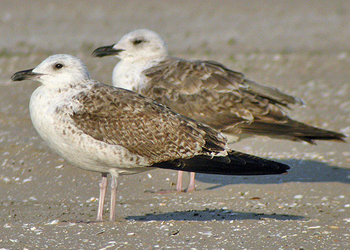 |
 |
| 389 Probable Baltic Gull Larus fuscus fuscus (front), second calendar-year, with Lesser Black-backed Gull L f graellsii/intermedius, Amsterdam, Noord-Holland, Netherlands, 28 June 2005 (Ruud G M Altenburg). Compare primaries: brown and pointed juvenile feathers in graellsii/intermedius in the back, black and rounded second generation feathers in the probable nominate fuscus. 'Barred' plumage is occasionally seen in nominate fuscus but is much more common in western birds. Although likely to be pure nominate fuscus, theoretically birds like this could represent intergrade intermedius x nominate fuscus and, in our view, are better left unidentified. | |
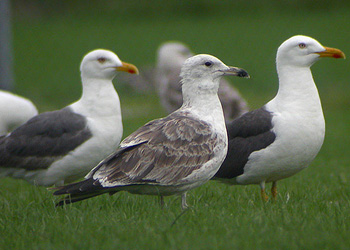 |
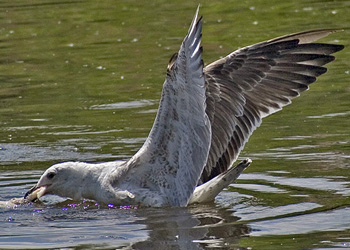 |
| 390 'Lesser black-backed gull' Larus fuscus/heuglini, second calendar-year, Amsterdam, Noord-Holland, Netherlands, 25 June 2006 (Ruud G M Altenburg). All primaries renewed, except for outer ones which are very worn. By mid-July, this bird was replacing inner primaries to third generation feathers. Such moult pattern is found only in most advanced Baltic Gulls L f fuscus but third generation scapulars and wing-coverts are too pale grey for this taxon. Although 'paler-than-average' nominate fuscus have hatched in Finland (cf Koskinen & Rauste 2006), it is safest to leave such individuals unidentified until variation in Heuglin's Gull L heuglini is better understood. | |
 |
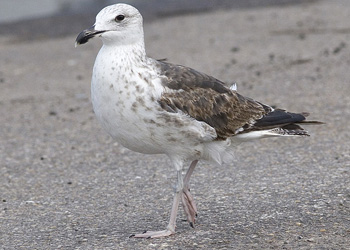 |
| 391 Presumed Baltic Gull Larus fuscus fuscus, second calendar-year, IJmuiden, Noord-Holland, Netherlands, 1 September 2006 (Mars J M Muusse). Rare example of individual showing three generations of primaries. In left wing, p1 is third generation, p2-7 second generation and p8-10 juvenile; p5 is broken off. In right wing, moult score is similar but p1 is missing/growing and p4 seems to be damaged. Most likely moult scenario is that this bird returned to Europe with tail, secondaries and p1-7 renewed on wintering grounds. Judging from poor state of primaries, instead of continuing with p8, it recommenced with p1. Note that, on current criteria, this bird cannot be accepted by the Dutch rarities committee (CDNA) and is therefore referred to as presumed. |
|
Third calendar-year birds
Winters' (2006) criterion for third calendar-year birds is far more restrictive than Jonsson's (1998), which only required a moult contrast to be present. Theoretically, this should exclude any third calendar-year intermedius but, in practice, such birds are inseparable from fourth calendar-year birds still showing significant signs of immaturity (plate 392). As unringed third calendar-year birds cannot be aged with absolute confidence, identification of this age class to subspecies level is not possible on current knowledge.
Conclusions and advice to rarities committees
Based on a combination of a fairly extensive data set of ringed western-type birds and a decade of field work, we are confident that the majority of second calendar-year nominate fuscus can be identified even when not wearing a (colour) ring. We suggest that rarities committees reconsider the decision to only accept ringed nominate fuscus of known provenance. Correct ageing of candidate birds is obviously critical, and it is important to note that this is not always straightforward.
We also conclude that, because of the occasional immature-looking fourth calendar-year nominate fuscus, third calendar-year birds cannot safely be aged. The implication of this is that unringed birds of this age are not identifiable with certainty. On current knowledge, this leaves second calendar-year birds of the type described above as the only identifiable age class of unringed nominate fuscus.
Further information
A dedicated section on the Gull Research Organisation website (www.gull-research.org/2cyfuscus) provides additional photographs of the individuals in plate 385-391, as well as a series of acceptable and non-acceptable individuals that are not discussed in this paper.
Acknowledgements
We thank Peter Adriaens, Chris Gibbins and Hannu Koskinen for their comments on the manuscript. Oskar Kenneth Bjørnstad, Roland-Jan Buijs, Kees Camphuysen, Morten Helberg and Nils Helge Lorentzen kindly helped us to extend our database of ringed birds. Special thanks go out to the following photographers: Toni Alcocer, Lucien Brinkhof, Michael Davis, Ronald van Dijk, Miguel Domínguez Santaella, Marc Fasol, Nelson Fonseca, Roland François, Rafa García, Miguel Juan, Maarten van Kleinwee, Tony Le Huu Nghia, Jean-Pierre Leys, Richard Mielcarek, Maties Rebassa, François Richir, Bram Rijksen, Luis José Salaverri Leiras, John Sanders, Jan Zorgdrager and in particular Delfín González, Antonio Gutierrez, Javier Marchamalo and Gabriel Martín.
References
Altenburg, R G M, Muusse, M J M, Luijendijk, B-J & Muusse, T O V 2006. Restricted moult in second
calendar-year Baltic Gull. Dutch Birding 28: 162-164.
Altenburg, R G M, Luijendijk, B-J, Muusse, M J M & Muusse, T O V 2007. Moult sequence in second
calendar-year Baltic Gull at Amsterdam in May 2006. Dutch Birding 29: 95-97.
Barth, E K 1966. Mantle colour as a taxonomic feature in Larus argentatus and Larus fuscus. Nytt Magasin for Zoologi 13: 56-82.
Gibbins, C N 2004. Is it possible to identify Baltic and Heuglin's Gulls? Birding Scotland 7: 154-186.
Jonsson, L 1998. Baltic Lesser Black-backed Gull Larus fuscus fuscus – moult, ageing and identification. Birding World 11: 295-317.
Koskinen, H & Rauste, V 2006. Primary moult of Baltic Gull during the first 15 months. Dutch Birding 28: 158-161.
Muusse, T O V, Muusse, M J M, Luijendijk, B-J & Altenburg, R G M 2005. Identification update: moult variability in 3rd calendar-year Lesser Black-backed Gulls. Birding World 18: 338-348.
Olsen, K M & Larsson, H 2004. Gulls of Europe, Asia and North America. Second edition. London.
Rauste, V 1999. Kennzeichen und Mauser von 'Baltischen Heringsmöwen' Larus [fuscus] fuscus und 'Tundramöwen' L. [fuscus] heuglini. Limicola 13: 105-128, 153-188.
Winters, R 2006. Moult and plumage variation in immature Lesser Black-backed Gulls in the Netherlands. Dutch Birding 28: 140-157.
 fuscus 2cy C0XX June 30 2002, Tampere, Finland (61.33N 24.59E). Pictures Visa Rauste.Very advanced looking bird, again moulting inner primaries.
fuscus 2cy C0XX June 30 2002, Tampere, Finland (61.33N 24.59E). Pictures Visa Rauste.Very advanced looking bird, again moulting inner primaries. fuscus 2cy CHYE June 14 & 29 2003, Tampere, Finland (61.33N 24.59E). Pictures Visa Rauste.Rather typical 2cy bird in spring.
fuscus 2cy CHYE June 14 & 29 2003, Tampere, Finland (61.33N 24.59E). Pictures Visa Rauste.Rather typical 2cy bird in spring. fuscus 2cy CJJR May - August 2005, Tampere, Finland (61.33N 24.59E). Pictures Hannu Koskinen & Visa Rauste.Slightly delayed bird in spring.
fuscus 2cy CJJR May - August 2005, Tampere, Finland (61.33N 24.59E). Pictures Hannu Koskinen & Visa Rauste.Slightly delayed bird in spring. fuscus 2cy CU7U June 14-21 2013, Pirkanmaa, Finland. Images: Hannu Koskinen. Retarded bird.
fuscus 2cy CU7U June 14-21 2013, Pirkanmaa, Finland. Images: Hannu Koskinen. Retarded bird. fuscus 2cy CV8U June 20 2013, Pirkanmaa, Finland. Images: Hannu Koskinen.
fuscus 2cy CV8U June 20 2013, Pirkanmaa, Finland. Images: Hannu Koskinen. fuscus 2cy CY03 June 07 2014, Tampere, Finland. Images: Hannu Koskinen.
fuscus 2cy CY03 June 07 2014, Tampere, Finland. Images: Hannu Koskinen. fuscus 2cy CYHP June-July 2004, Tampere, Finland (61.33N 24.59E). Pictures Hannu Koskinen & Visa Rauste.Delayed bird in spring. Turned into pale adult.
fuscus 2cy CYHP June-July 2004, Tampere, Finland (61.33N 24.59E). Pictures Hannu Koskinen & Visa Rauste.Delayed bird in spring. Turned into pale adult. Larus
fuscus fuscus 2cy C0U3 June 14 2014, Tampere, Finland. Images Hannu Koskinen.
Larus
fuscus fuscus 2cy C0U3 June 14 2014, Tampere, Finland. Images Hannu Koskinen. Larus
fuscus fuscus 2cy C19U June 10 2007, Tampere, Finland. Images Hannu Koskinen.
Larus
fuscus fuscus 2cy C19U June 10 2007, Tampere, Finland. Images Hannu Koskinen. Larus
fuscus fuscus 2cy C84A June 21 2007, Tampere, Finland. Images Hannu Koskinen.
Larus
fuscus fuscus 2cy C84A June 21 2007, Tampere, Finland. Images Hannu Koskinen.Also seen as 3cy.
 Larus
fuscus fuscus 2cy CHJ9 June & August 2006, Tampere, Finland. Images Hannu & Visa.
Larus
fuscus fuscus 2cy CHJ9 June & August 2006, Tampere, Finland. Images Hannu & Visa. Larus
fuscus fuscus 2cy CK66 June 10 2007, Tampere, Finland. Images Hannu Koskinen.
Larus
fuscus fuscus 2cy CK66 June 10 2007, Tampere, Finland. Images Hannu Koskinen. Larus
fuscus fuscus 2cy CRK4 June 25 2005, Amsterdam, the Netherlands. Images Ruud Altenburg.
Larus
fuscus fuscus 2cy CRK4 June 25 2005, Amsterdam, the Netherlands. Images Ruud Altenburg. Larus
fuscus fuscus 2cy CP48 June 12 2007, Tampere, Finland. Images Hannu Koskinen.
Larus
fuscus fuscus 2cy CP48 June 12 2007, Tampere, Finland. Images Hannu Koskinen. fuscus 2cy CLJ7 May 31 - July 04 2013, Koukku, Finland. Image: Hannu Koskinen. P1-P10 juvenile, complete moult starting in summer.
fuscus 2cy CLJ7 May 31 - July 04 2013, Koukku, Finland. Image: Hannu Koskinen. P1-P10 juvenile, complete moult starting in summer.
 fuscus 2cy CT-166.881 June 07 2014, Tampere, Finland. Images: Hannu Koskinen.
fuscus 2cy CT-166.881 June 07 2014, Tampere, Finland. Images: Hannu Koskinen. Larus fuscus fuscus 2cy June 07 2014, Tampere, Finland. Images Hannu Koskinen.
Larus fuscus fuscus 2cy June 07 2014, Tampere, Finland. Images Hannu Koskinen. Larus fuscus fuscus 2cy June 14 2014, Tampere, Finland. Images Hannu Koskinen.
Larus fuscus fuscus 2cy June 14 2014, Tampere, Finland. Images Hannu Koskinen. Larus fuscus fuscus 2cy June 21-22 & July 07 2014, Tampere, Finland. Images Hannu Koskinen.
Larus fuscus fuscus 2cy June 21-22 & July 07 2014, Tampere, Finland. Images Hannu Koskinen. Larus fuscus fuscus 2cy June 07 2014, Tampere, Finland. Images Hannu Koskinen.
Larus fuscus fuscus 2cy June 07 2014, Tampere, Finland. Images Hannu Koskinen. Larus fuscus fuscus 2cy June 07 2014, Tampere, Finland. Images Hannu Koskinen.
Larus fuscus fuscus 2cy June 07 2014, Tampere, Finland. Images Hannu Koskinen. Larus fuscus fuscus 2cy June 07 2014, Tampere, Finland. Images Hannu Koskinen.
Larus fuscus fuscus 2cy June 07 2014, Tampere, Finland. Images Hannu Koskinen. Larus fuscus fuscus 2cy June 20 2014, Tampere, Finland. Images Hannu Koskinen.
Larus fuscus fuscus 2cy June 20 2014, Tampere, Finland. Images Hannu Koskinen. Larus fuscus fuscus 2cy June 07-21 2014, Tampere, Finland. Images Hannu Koskinen.
Larus fuscus fuscus 2cy June 07-21 2014, Tampere, Finland. Images Hannu Koskinen. Larus fuscus fuscus 2cy June 07 2014, Tampere, Finland. Images Hannu Koskinen.
Larus fuscus fuscus 2cy June 07 2014, Tampere, Finland. Images Hannu Koskinen.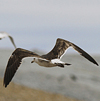 Larus fuscus fuscus 2cy June 14 2014, Tampere, Finland. Images Hannu Koskinen. P10 still juvenile in left wing.
Larus fuscus fuscus 2cy June 14 2014, Tampere, Finland. Images Hannu Koskinen. P10 still juvenile in left wing. Larus fuscus fuscus 2cy June 14 2014, Tampere, Finland. Images Hannu Koskinen.
Larus fuscus fuscus 2cy June 14 2014, Tampere, Finland. Images Hannu Koskinen. Larus fuscus fuscus 2cy June 14 2014, Tampere, Finland. Images Hannu Koskinen.
Larus fuscus fuscus 2cy June 14 2014, Tampere, Finland. Images Hannu Koskinen. Larus fuscus fuscus 2cy June 14 2014, Tampere, Finland. Images Hannu Koskinen.
Larus fuscus fuscus 2cy June 14 2014, Tampere, Finland. Images Hannu Koskinen. Larus fuscus fuscus 2cy June 07 2014, Tampere, Finland. Images Hannu Koskinen.
Larus fuscus fuscus 2cy June 07 2014, Tampere, Finland. Images Hannu Koskinen. Larus fuscus fuscus 2cy June 07 2014, Tampere, Finland. Images Hannu Koskinen.
Larus fuscus fuscus 2cy June 07 2014, Tampere, Finland. Images Hannu Koskinen. Larus fuscus fuscus 2cy June 14 2014, Tampere, Finland. Images Hannu Koskinen.
Larus fuscus fuscus 2cy June 14 2014, Tampere, Finland. Images Hannu Koskinen. Larus fuscus fuscus 2cy June 07 2014, Tampere, Finland. Images Hannu Koskinen.
Larus fuscus fuscus 2cy June 07 2014, Tampere, Finland. Images Hannu Koskinen. Larus fuscus fuscus 2cy June 22 2014, Tampere, Finland. Images Hannu Koskinen.
Larus fuscus fuscus 2cy June 22 2014, Tampere, Finland. Images Hannu Koskinen. Larus fuscus fuscus 2cy June 14 2014, Tampere, Finland. Images Hannu Koskinen.
Larus fuscus fuscus 2cy June 14 2014, Tampere, Finland. Images Hannu Koskinen. Larus fuscus fuscus 2cy June 14 2014, Tampere, Finland. Images Hannu Koskinen.
Larus fuscus fuscus 2cy June 14 2014, Tampere, Finland. Images Hannu Koskinen. Larus
fuscus fuscus 2cy June 08 2008, Tampere, Finland. Images Hannu Koskinen.
Larus
fuscus fuscus 2cy June 08 2008, Tampere, Finland. Images Hannu Koskinen. Larus fuscus fuscus 2cy June 08 2008, Tampere, Finland. Images Hannu Koskinen.
Larus fuscus fuscus 2cy June 08 2008, Tampere, Finland. Images Hannu Koskinen. Larus fuscus fuscus 2cy June 14 2014, Tampere, Finland. Picture: Hannu Koskinen.
Larus fuscus fuscus 2cy June 14 2014, Tampere, Finland. Picture: Hannu Koskinen. Larus fuscus fuscus 2cy June 14 2014, Tampere, Finland. Picture: Hannu Koskinen.
Larus fuscus fuscus 2cy June 14 2014, Tampere, Finland. Picture: Hannu Koskinen. Larus fuscus fuscus 2cy June 14 2014, Tampere, Finland. Picture: Hannu Koskinen.
Larus fuscus fuscus 2cy June 14 2014, Tampere, Finland. Picture: Hannu Koskinen. Larus fuscus fuscus 2cy June 14 2014, Tampere, Finland. Picture: Hannu Koskinen.
Larus fuscus fuscus 2cy June 14 2014, Tampere, Finland. Picture: Hannu Koskinen. Larus fuscus fuscus 2cy June 20-21 & July 06 2014, Tampere, Finland. Picture: Hannu Koskinen.
Larus fuscus fuscus 2cy June 20-21 & July 06 2014, Tampere, Finland. Picture: Hannu Koskinen. Larus fuscus fuscus 2cy June 21-22 & July 15 2014, Tampere, Finland. Picture: Hannu Koskinen.
Larus fuscus fuscus 2cy June 21-22 & July 15 2014, Tampere, Finland. Picture: Hannu Koskinen. Larus
fuscus fuscus 2cy June 11-18 2008, Tampere, Finland. Images Hannu Koskinen. Old primaries.
Larus
fuscus fuscus 2cy June 11-18 2008, Tampere, Finland. Images Hannu Koskinen. Old primaries. Larus
fuscus fuscus 2cy June 11-18 2008, Tampere, Finland. Images Hannu Koskinen.
Larus
fuscus fuscus 2cy June 11-18 2008, Tampere, Finland. Images Hannu Koskinen. Larus
fuscus fuscus 2cy June 02 2008, Tampere, Finland. Images Hannu Koskinen.
Larus
fuscus fuscus 2cy June 02 2008, Tampere, Finland. Images Hannu Koskinen. Larus
fuscus fuscus 2cy June 08 2008, Tampere, Finland. Images Hannu Koskinen.
Larus
fuscus fuscus 2cy June 08 2008, Tampere, Finland. Images Hannu Koskinen. Larus fuscus fuscus 2cy June 14 2014, Tampere, Finland. Picture: Hannu Koskinen.
Larus fuscus fuscus 2cy June 14 2014, Tampere, Finland. Picture: Hannu Koskinen. Larus fuscus fuscus 2cy June 20-21 2014, Tampere, Finland. Picture: Hannu Koskinen.
Larus fuscus fuscus 2cy June 20-21 2014, Tampere, Finland. Picture: Hannu Koskinen. Larus
fuscus fuscus 2cy June 08 2008, Tampere, Finland. Images Hannu Koskinen.
Larus
fuscus fuscus 2cy June 08 2008, Tampere, Finland. Images Hannu Koskinen. Larus
fuscus fuscus 2cy June 07 2008, Tampere, Finland. Images Markkhu Kangasniemi.
Larus
fuscus fuscus 2cy June 07 2008, Tampere, Finland. Images Markkhu Kangasniemi. L. f. fuscus 2cy June 24 2011, Ashdod, Israel. Picture: Amir Ben Dov.
L. f. fuscus 2cy June 24 2011, Ashdod, Israel. Picture: Amir Ben Dov. Larus
fuscus fuscus 2cy June 13 2008, Tampere, Finland. Images Hannu Koskinen. Pale bird.
Larus
fuscus fuscus 2cy June 13 2008, Tampere, Finland. Images Hannu Koskinen. Pale bird.
